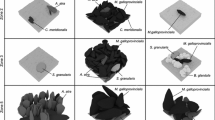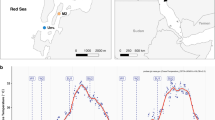Abstract
Measures of biodiversity along environmental gradients have long been the focus of marine ecological research. However, a general lack of comparability between studies and under-appreciation of co-occurring, less obvious clines has often undermined any general conclusions. Latitudinal, vertical, horizontal, and taxonomic gradients in intertidal biodiversity were assessed directly and indirectly using a large data set from one locality in southwest Ireland. A total of 153 epifaunal species, from 106 families and 13 phyla, was recorded from over 200,000 individuals in a sample area of 63 m2. Multivariate analysis revealed that the vertical gradient of immersion was the primary structuring factor in the community but that a flow-driven horizontal gradient was also important in structuring low- and mid-shore zones. Crustaceans, annelids, and molluscs were most numerous over the entire site, but bryozoans and sponges may have played the most significant role in driving the horizontal (flow-related) trend in species richness at lower levels on the shore. Comparison of species richness with sites from other locations around the world proved inconclusive in assessing a global trend in richness from the poles to the tropics. However, interpolation of this and similar studies may prove useful in future latitudinal investigations of hard-substratum intertidal biota. Higher-taxon surrogacy for species trends proved significant and useful at the scale investigated here, whereby analysis of data from family or even order level may prove an efficient method of future monitoring. More data are required to assess if the ‘top-down’ taxonomic approach will sufficiently mirror species trends at larger spatial scales. Overall, the generality of effects of environmental gradients on intertidal organisms may be more conclusive where entire communities are studied and consideration is given to other, less dominant clines.







Similar content being viewed by others
References
Andersen AN (1995) Measuring more of biodiversity: genus richness as a surrogate for the species richness in Australian ant faunas. Biol Conserv 73:39–43
Attrill MJ, Stafford R, Rowden AA (2001) Latitudinal diversity patterns in estuarine tidal flats: indications of a global cline. Ecography 24:318–324
Balmford A, Jayasuriya AHM, Green MJB (1996) Using higher-taxon richness as a surrogate for species richness: II. Local applications. Proc R Soc Lond B 263:1571–1575
Barnes DKA, Arnold RJ (2001) Competition, sublethal mortality and diversity on Southern Ocean coastal boulder communities. Polar Biol 24:447–454
Barnes DKA, Brockington S (2003) Zoobenthic biodiversity, biomass and abundance at Adelaide Island, Antarctica. Mar Ecol Prog Ser 249:145–155
Barnes DKA, Rothery P, Clarke A (1996) Colonisation and development in encrusting communities from the Antarctic intertidal and sublittoral. J Exp Mar Biol Ecol 196:251–265
Barnes RSK, Hughes RN (1988) An introduction to marine ecology, 2nd edn. Blackwell Scientific, Oxford
Bassindale R, Davenport E, Ebling FJ, Kitching JA, Sleigh MA, Sloane JF (1957) The ecology of the Lough Ine rapids with special reference to water currents VI. Effects of the rapids on the hydrography of the south basin. J Ecol 45:879–900
Bell G, Lechowicz MJ, Appenzeller A, Chandler M, DeBlois E, Jackson L, MacKenzie B, Preziosi R, Schallenberg M, Tinker N (1993) The spatial structure of the physical environment. Oecologia 96:114–121
Bell JJ, Barnes DKA (2000) The influence of bathymetry and flow regime upon the morphology of sublittoral sponge communities. J Mar Biol Assoc UK 80:707–718
Bell JJ, Barnes DKA (2002) The relationship between sedimentation, flow rates, depth and time at Lough Hyne Marine Nature Reserve. Ir Nat J 27:18–28
Benedetti-Cecchi L (2001) Variability in abundance of algae and invertebrates at different spatial scales on rocky sea shores. Mar Ecol Prog Ser 215:79–92
Benedetti-Cecchi L, Cinelli F (1997) Spatial distribution of algae and invertebrates in the rocky intertidal zone of the Strait of Magellan: are patterns general? Polar Biol 18:337–343
Broitman BR, Navarete SA, Smith F, Gaines SD (2001) Geographic variation of southeastern Pacific intertidal communities. Mar Ecol Prog Ser 224:21–34
Clarke A (1992) Is there a latitudinal diversity cline in the sea? Trends Ecol Evol 7:286–287
Clarke A, Lidgard S (2000) Spatial patterns of diversity in the sea: bryozoan species richness in the North Atlantic. J Anim Ecol 69:799–814
Clarke KR, Warwick RM (1998) A taxonomic distinctness index and its statistical properties. J Appl Ecol 35:523–531
Connell JH (1961) Effect of competition, predation by Thais lappilus, and other factors on natural populations of the barnacle Balanus balanoides. Ecol Monogr 31:61–104
Connell JH (1972) Community interactions on marine rocky intertidal shores. Annu Rev Ecol Syst 3:169–192
Connell JH (1978) Diversity in tropical rain forests and coral reefs. Science 199:1302–1309
Culver SJ, Buzas MA (2000) Global latitudinal species diversity gradient in deep-sea benthic foraminifera. Deep-Sea Res 47:259–275
Davidson IC, Crook AC, Barnes DKA (2004) Quantifying spatial patterns of biodiversity: is movement important? Pubbl Stn Zool Napoli Mar Ecol 25:15–34
Doerries MB, Van Dover CL (2003) Higher-taxon richness as a surrogate for species richness in chemosynthetic communities. Deep-Sea Res 50:749–755
Ebling FJ, Sleigh MA, Sloane JF, Kitching JA (1960) Distribution of some common plants and animals of the littoral and shallow sublittoral regions. J Ecol 48:29–53
Ellingsen KI, Gray JS (2002) Spatial patterns of benthic diversity: is there a latitudinal gradient along the Norwegian continental shelf. J Anim Ecol 71:373–389
Gaston KJ (2000) Global patterns in biodiversity. Nature 405:220–227
Gaston KJ, Williams PH (1993) Mapping the world’s species—the higher taxon approach. Biodivers Lett 1:2–8
Gaston KJ, Williams PH, Eggelton P, Humphries CJ (1995) Large scale patterns of biodiversity: spatial variation in family richness. Proc R Soc Lond B 260:149–154
Gotelli NJ, Colwell RK (2001) Quantifying biodiversity: procedures and pitfalls in the measurement and comparison of species richness. Ecol Lett 4:379–391
Gotelli NJ, Entsminger GL (2001) EcoSim: null models software for ecology, version 7.0. Acquired Intelligence and Kesey-Bear, Burlington, Vt. http://homepages.together.net/~gentsmin/ecosim.htm
Gray JS (1997) Gradients in marine biodiversity. In: Ormond RFG, Gage JD, Angel MV (eds) Marine biodiversity: patterns and processes. Cambridge University Press, Cambridge, pp 18–34
Gray JS (2001) Marine diversity: paradigms in patterns of species richness examined. Sci Mar 65:41–56
Hameed S, Ahmed M (2000) Distribution and abundance of intertidal macro-invertebrates on the rocky bench of Pacha, near Karachi. Int J Ecol Environ Sci 26:149–163
Hily C, Jean F (1997) Macrobenthic biodiversity in intertidal habitats of the Iroise biosphere reserve (Brittany, France). J Mar Biol Assoc UK 77:311–323
Howson CM, Picton BE (1997) The species directory of the marine fauna and flora of the British Isles and the surrounding seas. Ulster Museum and the Marine Conservation Society, Belfast and Ross-on-Wye
Huston M (1979) A general hypothesis of species diversity. Am Nat 113:81–101
Kelaher BP, Chapman MG, Underwood AJ (2001) Spatial patterns of diverse macrofaunal assemblages in coralline turf and their associations with environmental variables. J Mar Biol Assoc UK 81:917–930
Kendall MA, Aschan M (1993) Latitudinal gradients in the structure of macrobenthic communities: a comparison of Arctic, temperate and tropical sites. J Exp Mar Biol Ecol 172:157–169
Kitching JA (1987) Ecological studies at Lough Hyne. Adv Ecol Res 17:115–186
Leonard GH, Levine JM, Schmidt PR, Bertness MD (1998) Flow-driven variation in intertidal community structure in a Maine estuary. Ecology 79:1395–1411
Lewis JR (1964) The ecology of rocky shores. English University Press, London
Little C (1991) Ecology of the rocky intertidal zone. In: Myers AA, Little C, Costello MJ, Partridge JC (eds) The ecology of Lough Hyne. Proceedings of a conference, 4–5 September 1990. Royal Irish Academy, Dublin, pp 53–69
Maughan BC, Barnes DKA (2000a) Epilithic boulder communities of Lough Hyne, Ireland: the influences of water movement and sediment. J Mar Biol Assoc UK 80:767–776
Maughan BC, Barnes DKA (2000b) A ‘minimum stress inflexion’ in relation to environmental and biotic influences on the dynamics of subtidal encrusting communities. Hydrobiologia 440:101–109
May RM (1994) Biological diversity: differences between land and sea. Philos Trans R Soc Lond B 343:105–111
McCabe DJ, Gotelli NJ (2000) Effects of disturbance frequency, intensity, and area on assemblages of stream macroinvertebrates. Oecologia 124:270–270
McGuinness KA (1990) Physical variability, diversity gradients and the ecology of temperate and tropical reefs. Aust J Ecol 15:465–476
Menconi M, Benedetti-Cecchi L, Cinelli F (1999) Spatial and temporal variability in the distribution of algae and invertebrates on rocky shores in the northwest Mediterranean. J Exp Mar Biol Ecol 233:1–23
Menge BA, Sutherland JP (1987) Community regulation: variation in disturbance, competition, and predation in relation to environmental stress and recruitment. Am Nat 130:730–757
Menge BA, Lubechenco J, Ashkenas LR (1985) Diversity, heterogeneity and consumer pressure in a tropical rocky intertidal community. Oecologia 65:394–405
Murphy N (1999) An investigation into the tidal regime and the motion of water currents in Lough Hyne, southwest Ireland, with the aid of a numerical model. Unpublished MSc thesis, Institute of Marine Studies, University of Plymouth
Myers AA, Little C, Costello MJ, Partridge JC (eds) (1991) The ecology of Lough Hyne. Proceedings of a conference, 4–5 September 1990. Royal Irish Academy, Dublin
Paine RT (1974) Intertidal community structure: experimental studies on the relationship between a dominant competitor and its principal predator. Oecologia 15:93–120
Pianka ER (1966) Latitudinal gradients in species diversity: a review of concepts. Am Nat 100:33–46
Prance GT (1994) A comparison of the efficacy of higher taxa and species numbers in the assessment of biodiversity in the neotropics. Philos Trans R Soc Lond B 345:89–99
Rex MA, Stuart CT, Hessler RR, Allen JA, Sanders HL, Wilson GDF (1993) Global-scale latitudinal patterns of species diversity in the deep-sea benthos. Nature 365:636–639
Roy K, Jablonski D, Valentine JW (1996) Higher taxa in biodiversity studies: patterns from the eastern Pacific marine molluscs. Philos Trans R Soc Lond B 351:1605–1613
Sanders HL (1968) Marine benthic diversity: a comparative study. Am Nat 102:243–282
Schoch GC, Dethier MN (2002) Puget Sound intertidal biodiversity: scales of variability for invertebrate and algal communities on gravel beaches. Report to the Washington state department of natural resources, Olympia, Wash.
Sloane JF, Bassindale R, Davenport E, Ebling EJ, Kitching JA (1961) The ecology of the Lough Ine IX. The flora and fauna associated with undergrowth-forming algae in the rapids area. J Ecol 49:353–368
Somerfield PJ, Clarke KR (1995) Taxonomic levels in marine community studies revisited. Mar Ecol Prog Ser 127:113–119
Stehli FG, Douglas RG, Newell ND (1969) Generation and maintenance of gradients in taxonomic diversity. Science 164:947–949
Stephenson TA, Stephenson A (1949) The universal features of zonation between tide-marks on rocky coasts. J Ecol 37:289–305
Suchanek TH (1992) Extreme biodiversity in the marine environment: mussel bed communities of Mytilus californianus. Northw Environ J 8:150–152
Ugland KI, Gray JS, Ellingsen KE (2003) The species-accumulation curve and estimation of species richness. J Anim Ecol 72:888–897
Underwood AJ (1997) Experiments in ecology: their logical design and interpretation using analysis of variance. Cambridge University Press, Cambridge
Weslawski JM, Zajaczkowski M, Kwasniewski S, Jezierski J, Moskal W (1988) Seasonality in an Arctic fjord ecosystem: Horsund, Spitsbergen. Polar Res 6:185–189
Weslawski JM, Wiktor J, Zajaczkowski M, Swerpel S (1993) Intertidal zone of Svalbard 1. Macroorganism distribution and biomass. Polar Biol 13:73–79
Williams PH, Humphries CJ, Gaston KJ (1994) Centres of seed plant diversity: the family way. Proc R Soc Lond B 256:67–70
Acknowledgements
The author wishes to thank David Barnes and Anne Crook for guidance and comments on earlier drafts of the manuscript and for field assistance. Two anonymous reviewers also contributed to improvements in the manuscript. I am grateful to James Bell for advice on analysis and sponge identification and the Lough Hyne Research Group for help during fieldwork. Thanks also to Declan O’Donnell (Duchas) for granting a permit to conduct research at Lough Hyne Marine Nature Reserve. This work was funded by the Higher Education Authority (H. E. A.), Ireland.
Author information
Authors and Affiliations
Corresponding author
Additional information
Communicated by J.P. Thorpe, Port Erin
Rights and permissions
About this article
Cite this article
Davidson, I.C. Structural gradients in an intertidal hard-bottom community: examining vertical, horizontal, and taxonomic clines in zoobenthic biodiversity. Marine Biology 146, 827–839 (2005). https://doi.org/10.1007/s00227-004-1478-4
Received:
Accepted:
Published:
Issue Date:
DOI: https://doi.org/10.1007/s00227-004-1478-4




